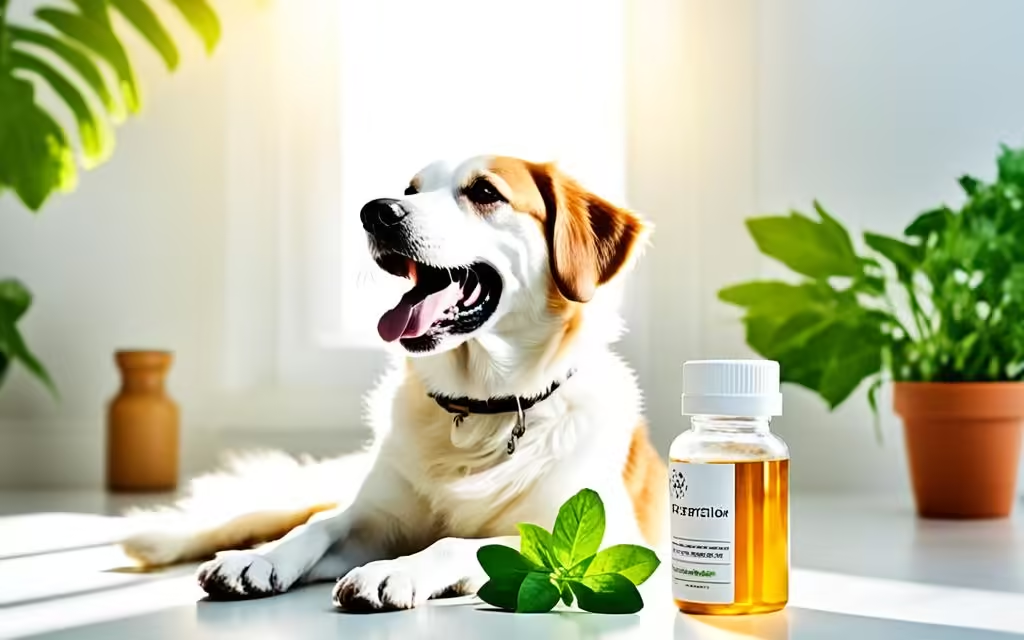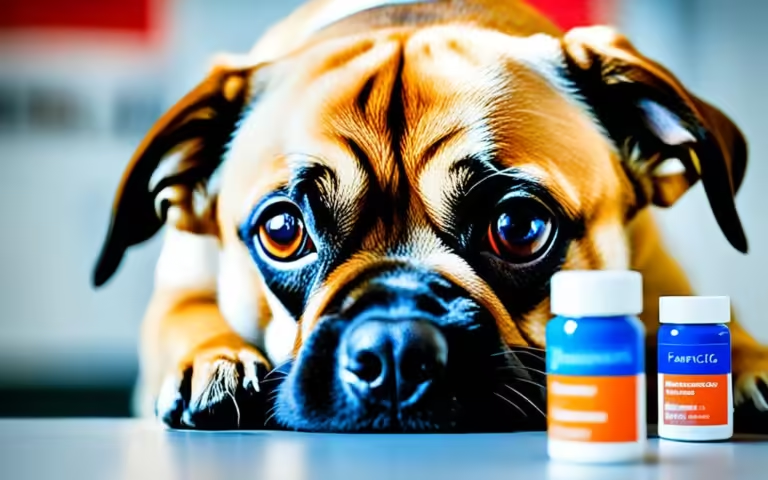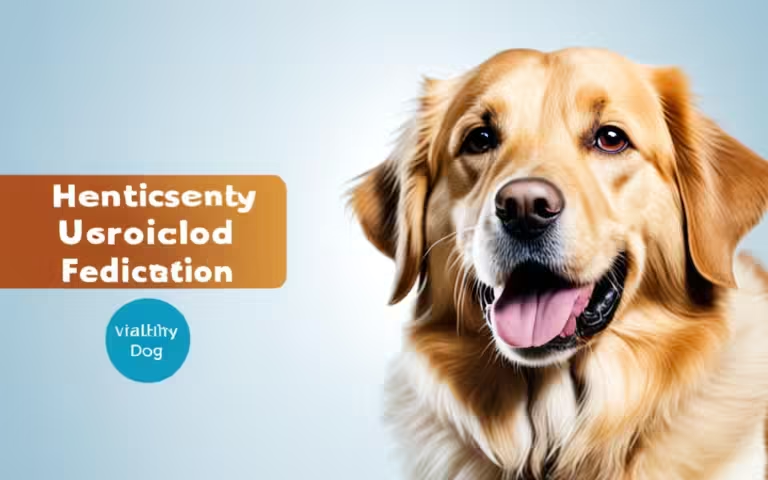Penicillin for Dog: Uses, Safety, and Administration
Did you know that dogs and cats usually get 10,000 to 25,000 units of penicillin per pound? This is given two to six times a day1. This antibiotic helps fight off bacterial infections in many animals, like dogs, cats, cattle, horses, and swine2. For pets, it’s key to know how to use, keep safe, and give penicillin right to help your pet stay healthy.
Key Takeaways
- Penicillin G is an effective antibiotic used to treat bacterial infections in dogs and cats.
- The injectable form of penicillin G is FDA-approved for use in various animals, including dogs and cats.
- Proper dosage and administration are crucial to ensure the safe and effective use of penicillin in dogs.
- Penicillin G can have side effects such as diarrhea or loose stools, and allergic reactions are a concern.
- Consulting a veterinarian is recommended before administering penicillin to your dog.
Table of Contents
What is Penicillin?
Overview and FDA Approval
Penicillin is an antibiotic that stops bacteria from making a key part of their cell wall. This makes the bacteria weak and kills it3. It’s approved for use in many animals, including dogs, for fighting infections in their breathing and skin3.
Types of Penicillin for Dogs
There are many kinds of penicillin, like penicillin G, penicillin V, and amoxicillin3. Penicillin V is used in humans and can be made into a liquid for dogs4. Even though it’s not made for pets, vets can give it to animals if needed4.
Amoxicillin is often given to dogs because it works against many types of bacteria and is not too expensive3. Dogs with stomach problems often get metronidazole3. Other antibiotics for dogs include Cefazolin, enrofloxacin, and doxycycline3.
Medicines made just for pets are safer for dogs than human medicines because they don’t have harmful ingredients3. Dogs might get sick from antibiotics, showing signs like drooling and diarrhea3. Too many antibiotics can make bacteria resistant, which is a big problem3.
| Penicillin Types | Effectiveness | Dosage | FDA Approval |
|---|---|---|---|
| Penicillin G | Works against many bacteria4 | 5-10 mg/lb every 12 hours4 | Approved for pets4 |
| Penicillin V | Good against some bacteria4 | Not for pets, but vets can use it4 | Approved for humans4 |
| Amoxicillin | Works against many bacteria35 | Often given to dogs35 | Approved for pets5 |
Penicillin is key in treating bacterial infections in dogs, with different forms for various infections.
“Penicillin is great against infections from certain bacteria in dogs.”4
345
How Penicillin Works for Dogs
Penicillin is a strong antibiotic that has been used for many years to treat bacterial infections in dogs. It’s important to know how it works to understand its effectiveness in fighting off illnesses6.
Penicillin stops bacteria from making a key part of their cell wall. This wall is crucial for the bacteria’s survival6. Without it, the bacteria can’t protect itself and will eventually die. This is how penicillin kills bacteria6.
Penicillin works by blocking an enzyme called transpeptidase. This enzyme is vital for building the bacterial cell wall7. Without this enzyme, the cell wall can’t form properly, leading to the cell’s destruction7.
Penicillin is best against Gram-positive bacteria, which have a thick cell wall7. But, it’s not as effective against Gram-negative bacteria, which have an extra layer of protection7.
Studies show that penicillin is very good at treating bacterial infections in dogs8. It kills the bacteria by breaking down their cell walls. This lets the dog’s immune system fight off the infection and heal8.
Using antibiotics like penicillin too much can make bacteria resistant to them8. This is why it’s important to use antibiotics only as directed by a vet8.
In short, penicillin stops bacteria from making a key cell wall part, leading to their death and the dog’s recovery6. Knowing how it works helps ensure it’s used safely and effectively in treating dogs.
Penicillin Dosage and Administration for Dogs
Dosage Guidelines
The right amount of penicillin for dogs depends on the type of penicillin, their age, weight, and health9. Dogs usually get 1 milliliter per 10 to 25 pounds of body weight. This is given by injection and repeated every 48 hours9. Beef cattle get 2 milliliters per 150 pounds of body weight, also injected, with another dose in 48 hours10. Dogs usually need 110,000 to 165,000 units per kilogram (50,000-75,000 units per pound) daily11.
Directions for Use
Penicillin is often given as an injection but comes in tablets, liquid, and gel too10. Each milliliter has 300,000 units of penicillin G as procaine in a stable mix10. To work best, follow your vet’s exact instructions10. Give penicillin tablets on an empty stomach. Mix and store liquid or suspension in the fridge, and throw away any left after 14 days10.
Stick to the recommended dosage and treatment length when giving penicillin to your dog10. Giving more than 3,000 units per pound or treating for over four days can cause antibiotic residues10. Injecting it into cattle, sheep, or pigs can cause local reactions that last beyond the withdrawal time10.
Don’t use penicillin in horses meant for human eating, and avoid it in beef cattle 30 days before slaughter9. Also, don’t use milk from treated animals for food within 48 hours after treatment10.
Always talk to your vet for the right dosage and follow their advice for using penicillin safely and effectively in your dog10. Following the right administration and withdrawal times is key to avoiding problems and keeping your dog healthy10.
Penicillin for Dog: Uses and Benefits
Penicillin is a common antibiotic for dogs with bacterial infections12. It treats wounds, skin infections, tooth abscesses, and bladder infections12. But, it doesn’t work on viruses or parasites like worms12.
Penicillin is great for fighting many types of bacterial infections13. It helps with skin, respiratory, stomach, and bladder infections13. Sometimes, it’s given with other antibiotics to fight tough bacteria12.
Most dogs can take penicillin without issues, but some might be allergic12. If your dog is allergic, the vet will find another option12.
You can give penicillin as an injection, pill, liquid, or gel12. The right dose and way to give it depends on the penicillin type, your dog’s age, and the infection12. Always follow your vet’s advice to use it right and prevent problems14.

In short, penicillin is a key antibiotic for dogs with bacterial infections12. With a vet’s guidance, it can make your dog feel better and healthy again13.
Missed a Dose of Penicillin for Your Dog
If you forget to give your dog their penicillin, don’t worry. Knowing what to do next is key. Missing a dose might mean your dog needs a longer treatment or a stronger antibiotic15.
First, stay calm. Call your vet right away for advice. They might tell you to give the missed dose now or skip it if it’s almost time for the next one16.
Never give your dog more medicine than prescribed to catch up. This can harm them. Your vet knows the best steps for your pet’s situation16.
Being consistent with medication is crucial. Missing doses can weaken the treatment and make bacteria resistant16. Follow your vet’s advice to help your dog get better and avoid problems.
Missing a dose can have serious effects, like high blood sugar in pets or flea and tick problems15. For penicillin, it could mean the infection doesn’t clear up, leading to a longer treatment or stronger medicine15.
Your vet knows how to handle a missed dose safely and effectively151617.
Potential Side Effects of Penicillin for Dogs
Penicillin is usually safe for dogs, but like all meds, it can have side effects. It’s important for pet owners to know these effects to take good care of their dogs.
Common Side Effects
One common side effect is stomach issues like vomiting, diarrhea, and not wanting to eat4. Penicillin V is not made for pets but vets can give it to dogs in some cases. But, it’s not safe for some animals like horses, rabbits, and guinea pigs because it can cause serious diarrhea4.
Allergic Reactions
Some dogs might be allergic to penicillin or similar antibiotics4. Signs of an allergic reaction include skin rashes, fever, swelling, and trouble breathing18. If a dog is allergic to penicillin, tell the vet and look for other treatments4.
It’s key for owners to watch their dogs for any bad reactions to meds19. If a dog shows signs like vomiting, diarrhea, being very tired, or having trouble breathing, call the vet right away19.

Knowing about penicillin’s side effects helps pet owners keep their dogs safe and healthy41819.
Penicillin for Dog: Precautions and Safety Considerations
Drug Interactions
Penicillin is usually safe for dogs, but watch out for drug interactions20. Some penicillins can change lab test results. Always tell your vet if your dog is on penicillin or other meds, even over-the-counter ones21.
Drugs that might not mix well with penicillin include other antibiotics, drugs for fighting off gout, and some medicines for uric acid stones20. Always talk to your vet before giving your dog penicillin or any other medicine21.
| Antibiotic | Indicated Uses | Potential Side Effects |
|---|---|---|
| Amoxicillin | Respiratory tract infections, urinary tract infections, gastrointestinal infections, skin infections (abscesses, lacerations, and wounds) | Diarrhea, vomiting, and loss of appetite |
| Amoxicillin/Clavulante | Skin infections, soft tissue infections, periodontal infections, urinary tract infections | Diarrhea, vomiting, loss of appetite |
| Azithromycin | Skin infections, protozoal infections, ileus | Diarrhea, vomiting, loss of appetite |
| Cephalexin | Skin infections, urinary tract infections | Diarrhea, vomiting, loss of appetite |
| Cefpodoxime | Skin infections, urinary tract infections | Diarrhea, vomiting, loss of appetite |
| Cefovecin/Convenia | Skin infections, urinary tract infections | Diarrhea, vomiting, loss of appetite |
| Clindamycin | Skin infections, dental infections, osteomyelitis, systemic infections | Diarrhea, vomiting, loss of appetite |
| Doxycycline | Leptospirosis, tick-borne diseases, periodontal infections, heartworm disease | Vomiting, nausea, loss of appetite |
| Erythromycin | Susceptible infections | Diarrhea, vomiting, loss of appetite |
| Marbofloxacin/Zeniquin | Skin infections, urinary tract infections, leishmaniasis | May cause skin to be more prone to sunburn |
Always follow your vet’s advice when giving penicillin to your dog. Tell them about any strange side effects or health changes21. Knowing about drug interactions and being careful helps keep your dog safe and healthy while on penicillin22.
Penicillin for dog: Alternatives and Comparisons
Penicillin is often given to dogs to fight bacteria, but some bacteria have become resistant to it3. To tackle these resistant bacteria, vets often mix penicillin with other antibiotics. Amoxicillin is a good alternative for treating infections in dogs, like urinary tract infections and skin infections3. It’s often paired with clavulanate to fight bacteria that penicillin can’t beat23.
Vets have many other antibiotics for dogs with bacterial infections24. Options include Enrofloxacin (Baytril), Metronidazole (Flagyl), and others3. Each antibiotic has its own strengths and risks that vets must consider3. Using antibiotics wrongly can cause problems like drooling and shaking3.
Antibiotic resistance is a big worry in vet medicine. Overusing antibiotics can create superbugs hard to treat3. Vets stress the need for professional advice before giving antibiotics to dogs. This helps avoid risks3.
In short, while penicillin is still useful for dogs, vets have many other options for tough infections. Knowing the good and bad of each antibiotic is key to treating dogs safely and effectively24.
“Responsible use of antibiotics is crucial in veterinary medicine to prevent the spread of antibiotic-resistant bacteria and protect the health of our canine companions.”
Conclusion
Penicillin is a key antibiotic for dogs with bacterial infections. It comes in injectable, oral, and topical forms. It’s important to use the right amount and way for safety and effectiveness25.
Knowing about possible side effects and drug interactions is crucial. This helps dog owners and vets use penicillin safely25.
Every year, millions of Americans get bitten by dogs, leading to infections2526. Using antibiotics like penicillin can lower the risk of infection and complications. This shows how important penicillin is in vet care27.
Following the right guidelines for giving penicillin helps pets get better and stay healthy252627.
This article highlights how penicillin helps dogs with infections. It’s important to know how to use it safely and its role in dealing with dog bites and infections252627. By staying informed and working with vets, dog owners can make the best choices for their pets.
FAQ
What is penicillin and how is it used in veterinary medicine?
What are the different types of penicillin used for dogs?
How does penicillin work to kill bacteria in dogs?
What is the proper dosage and administration of penicillin for dogs?
What types of infections can penicillin treat in dogs?
What should I do if I forget to give my dog a dose of penicillin?
What are the potential side effects of penicillin in dogs?
Can dogs be allergic to penicillin?
Are there any drug interactions I should be aware of when giving my dog penicillin?
Are there any alternatives or comparisons to penicillin for treating dog infections?
Source Links
- Penicillin G for Dogs and Cats
- Penicillin for Dogs and Cats
- What to Know About Antibiotics for Dogs
- Penicillin for Dogs: Uses, Dosage, & Side Effects
- Amoxicillin | VCA Animal Hospitals
- How Much Amoxicillin Can I Give My Dog? Dosage Tips and More – GoodRx
- Antimicrobial use and resistance: FAQs for pet owners
- Can Dogs Have Amoxicillin?
- 21 CFR § 522.1696a – Penicillin G benzathine and penicillin G procaine suspension.
- Penicillin Injectable for Animal Use – Drugs.com
- Penicillin G or ampicillin for oral treatment of canine urinary tract infections – PubMed
- Penicillin for Dogs | Wag!
- Common Antibiotics for Dogs and Cats
- What you Should Know if Your Dog is on Antibiotics
- Does Missing a Dose of Your Pet’s Medication Put Them at Risk?
- Antibiotics: Essential Information
- Amoxicillin | VCA Animal Hospitals
- Are Antibiotics Safe for Dogs? Find Out! | Purina
- Side Effects of Pet Medications
- A Guide to the Top Antibiotics for Dogs – Whole Dog Journal
- What to Expect When Your Dogs Need Antibiotics
- Amoxicillin for Dogs and Cats
- No title found
- 1800PetMeds
- Prevention and Treatment of Dog Bites
- Dog bites
- Stanford study: Not all dog bites should be treated with antibiotics







